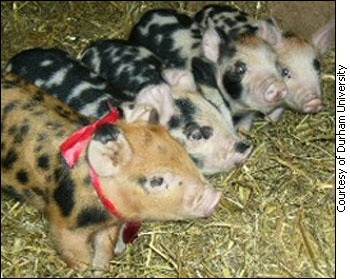 |
| Black-spotted pigs described
by Andersson and his research team whose coat colours
are the product of human selection. |
Thousands of years ago my great relatives were coloured
with coats of solid ebony, chocolate browns, and buttery
beiges – sensible looking wild dogs unbound by the
spots and stripes that have emerged so fashionable today.
I look down at my own pristine white coat – flecked,
spoiled, and sullied with black ugly specks – and
cannot help but sigh at the markings of human intervention.
Alas, I fear my complaints would fall upon deaf ears – being
a dog humans have trouble understanding me.
For years I’ve been listening to my owners, both molecular
biologists by trade, rant about lab mice and rare species
over dinner. Tonight’s table talk really made my ears
perk up.
The science unleashed
Researchers at Uppsala and Durham Universities have published
findings in the open-access journal PLoS Genetics, which
states that humans are actively changing the coat colouring
of domestic animals by weeding out and isolating rare mutations.
“I’ve been fascinated to use domestic animals
as a model for evolutionary biology,” says Leif Andersson,
co-author of the paper and professor at the department of
medical biochemistry and microbiology at Uppsala University. “Before
culture there was no domestication, so to understand the
history of this, provides a history of humanity.”
| 'There’s evidence
that we just like colour for the sake of colour. It’s
entirely aesthetic." |
Well, I’m glad he’s excited about a study that
has single-handedly exposed to canines the harsh reality
that owners everywhere are judging their pet by its coat– and
that the loyalty of dog’s best friend is shockingly
superficial.
Basically, the scientists traced a coat colour-controlling
gene, melanocortin-1 receptor (MC1R), in both wild boars
and domestic pigs from Asia and Europe.
By studying the alterations of this gene in both pig types
Andersson and his team were able to explain for the first
time in history why there are such differences in the coat
colourings of animals in captivity, and those same breeds
in the wild.
The research was funded by European and Swedish partners
as well as the European Molecular Biology Organization.
The team studied the effects of mutations in MC1R on the
pigs’ DNA. While some mutations have little effect
on animals, others cause strange patterns in coat colourings – thus
producing patchy Chinese Crested miniatures, and two-toned
piglets.
So why are these mutations surviving under human supervision
and disappearing from the wild? Researchers say that any
mutations occurring under Mother Nature’s watch are
eliminated by predators. The ability of animals with exotic
coat combinations to camouflage is hindered.
You can teach an old theory new tricks
The research teams’ results are significant in that
they blow some older theories out of the water.
One theory states that wild coat colouring was lost in domestic
animals because it was no longer necessary for animals to
protect themselves through camouflage.
Another behavioural-based theory states certain colour
genes were analogous with behaviour and when one was weeded
out, the other went with it.
“But we can see that this change in these animals has
been far too fast for these explanations,” says Andersson. “They
might be a by-product, but in this case we are studying a
gene that shows that there was a purpose in changing the
colour of domestic animals.”
Okay – so it’s clear that early farmers had
great reasons to alter their livestock’s coat colours – it
rendered their animals more identifiable next to their wild
kin, and made it difficult for them to hide in the fields.
But why change the colours of us household dogs and cats?
“There’s evidence that we just like colour for
the sake of colour. It’s entirely aesthetic,” says
bioarcheologist Greger Larson, co-author of the paper. “Historically
it was for practical purposes to distinguish your dog from
a wolf, but in modern times it’s to make the dog special.”
People are becoming just as picky about what colour their
poodle comes in as they are their own wardrobe. “Some
breeders prefer black spots and others white,” says
Andersson. “Some want solid, some want them spotted.”
All this talk of mutation isolation and genetic selection
can give a dog a complex. Should I be preparing myself for
a litter of puppies with spots the same shade as the new
curtains?
Front page courtesy of Durham University
|

